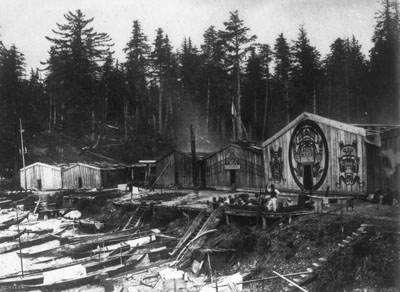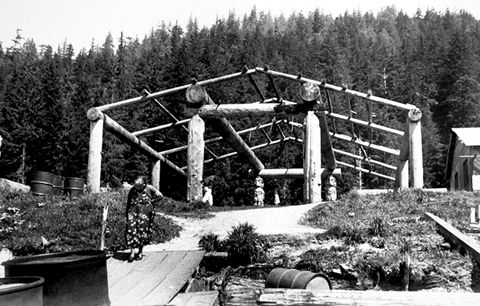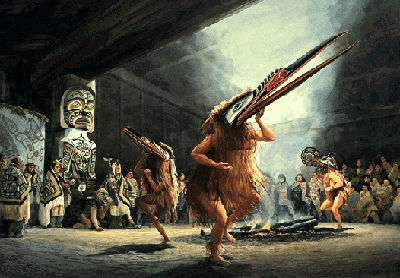The Kwakwaka'wakw peoples are traditional inhabitants of the coastal areas of northeastern Vancouver Island and mainland British Columbia. In the 2016 census, 3,670 people self-identified as having Kwakwaka’wakw ancestry.
Originally made up of approximately 28 communities speaking dialects of Kwak’wala — the Kwakwaka'wakw language —the number of communities was reduced by approximately half. After sustained contact beginning in the late 18th century, Europeans applied the name of one nation, the Kwakiutl, to the whole group in 1849, a tradition that persisted. The name Kwakwaka’wakw means those who speak Kwak’wala, which itself includes multiple dialects. (See also Northwest Coast Indigenous Peoples in Canada.)
Pre-contact Life
Archaeological evidence shows habitation in the Kwak’wala-speaking area for at least 8,000 years. Before contact with Europeans, Kwakwaka'wakw fished, hunted and gathered according to the seasons, securing an abundance of preservable food. Consequently, this allowed them to return to their winter villages for several months of intensive ceremonial and artistic activity. In addition, trails across Vancouver Island made trade possible with Nuu-chah-nulth villages on the west coast of the island.
Society and Culture
The culture of the Kwakwaka'wakw is similar to that of their northern neighbours, the Heiltsuk and Oowekyala peoples. The Potlatch, for example, is a ceremony that the Kwakwaka'wakw and some other Indigenous nations in British Columbia have been hosting since well before European contact. Though it was once outlawed by the Indian Act, the Potlatch remains an important part of modern community life.
The Kwakwaka’wakw are known for their artwork, distinct from other Northwest Coast Indigenous art in its style and cultural significance. In the carving of totem poles, for example, the Kwakwaka’wakw are known to carve creatures with narrow eyes, whereas the Haida poles typically have bold eyes.
Language
A member of the Wakashan language family, Kwak’wala is related to other Indigenous languages in British Columbia, such as those of the Nuu-chah-nulth (Nootka), Heiltsuk (Bella Bella), Oowekyala and Haisla (Kitamaat). The Kwak’wala language is considered endangered. Today, most Kwakwaka'wakw children speak English as their first language and there are few fluent speakers. In 2016, Statistics Canada reported 585 Kwak’wala speakers (though this figure does not specify their fluency level), with the majority living in British Columbia (99 per cent). As a means of preserving the language, some schools in the area sponsor programs in Kwak’wala.
Colonial History
In 1792, Spanish explorers Dionisio Alcalá-Galiano and Cayetano Valdés, and British Captain George Vancouver encountered most of the south Kwakwaka'wakw groups. Farther north, in 1849 the Hudson's Bay Company (HBC) established Fort Rupert, which operated until about 1882. After 1882, HBC sold the fort to Robert Hunt, the fort’s last factor (trader). In 1885, the land of Fort Rupert was transferred to Robert Hunt. Following this, Hunt and his wife, Mary Hunt (née Ebbetts), ran a store on this site. Mary Hunt, also known as Ansnaq or Anisalaga, is famous in her own right as a Chilkat weaver. George Hunt, Robert and Mary’s son, worked with anthropologist Franz Boas. Together, they recorded a large body of material on the language and culture of the Kwakwaka'wakw. Included in this work are Anisalaga’s weavings, which are held in museums around the world.
In 1885, the federal government enacted a law prohibiting the Potlatch, an important part of Kwakwaka'wakw culture. In 1921, a large Potlatch was secretly held at ʼMimkwa̱mlis (also spelled Memkumlis, and also known as Village Island) British Columbia. The Potlatch was hosted by Chief Dan Cranmer. As a result of the law prohibiting the Potlatch, 45 people were later arrested for participating in Chief Cranmer’s Potlatch. Approximately half of those arrested were imprisoned. Their ceremonial objects were confiscated. Knowing these masks and other ceremonial items were wrongfully taken, the Kwakwaka'wakw initiated efforts to secure their return. The National Museums of Canada agreed to return the part of the collection held by the Canadian Museum of Civilization (now the Canadian Museum of History). One condition for their return was the creation of two museums, the Kwakiutl Museum, now the Nuymbalees Cultural Centre, in Cape Mudge and the U'mista Cultural Centre in Alert Bay. (See also Northwest Coast Indigenous Art.)
Contemporary Life
Traditionally fishers, the Kwakwaka'wakw continue to fish commercially in a highly competitive industry. Hereditary chiefs still pass on rights and privileges at Potlatches, but band government is conducted by elected councillors.
A number of original villages have been abandoned as inhabitants have moved to communities such as Alert Bay, Campbell River and Port Hardy to be closer to schools and hospitals.
Founded in 1974, the U'mista Cultural Society works to ensure the survival of Kwakwaka’wakw cultural heritage. Located in Alert Bay, U'mista operates a museum and cultural education facility.
The Kwakwaka’wakw (listed as the Kwakiutl Nation) are in stage four of the British Columbia treaty process. There are six stages in total, with the end result aimed at self-government, monetary and land resources and the acknowledgment of Indigenous Rights and Title to territory. (See also Treaties with Indigenous Peoples in Canada.)

 Share on Facebook
Share on Facebook Share on X
Share on X Share by Email
Share by Email Share on Google Classroom
Share on Google Classroom










